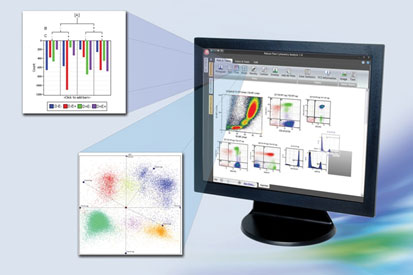 CUDA Spotlight: Bob ZigonBy Calisa Cole, posted Jan. 21, 2013  GPU-Accelerated Life SciencesThis week's Spotlight is on Bob Zigon of Beckman Coulter. Beckman Coulter develops, manufactures and markets products that simplify and automate complex biomedical testing. Q & A with Bob ZigonNVIDIA: Bob, what is your role at Beckman Coulter? For the six years prior to that, my team and I implemented three versions Kaluza, a CUDA-based application used in flow cytometry. Our goal was to build an application that would allow cancer researchers to interact with 800 megabyte leukemic data sets 200 times faster than existing software. By the time we shipped our third version, we were executing 400 times faster on a Fermi card than our competitors.
NVIDIA: Describe the users of your technology. Our flow cytometry customers, on the other hand, are divided into two groups: Research and Clinical. Our research customers are typically universities, biotech and pharmaceutical companies interested in studying leukemia and lymphoma. Our clinical customers are mainly hospitals. NVIDIA: Why is it important to accelerate data analysis for life science instruments? The subsequent analysis of the data can take days or weeks. During this time, a researcher will move the mouse (with existing software) and wait as long as seven minutes for the user interface to update because of the computations required. During that period of time, people can become distracted. They essentially forget the question they were trying to answer. This is unacceptable. Objectivity and an unbiased approach are critical to good science. In the last seven years, I have seen researchers avoid asking certain questions because they knew it would take too long to get an answer. This is where I start to blame the software. The software’s performance is so slow that it causes researchers to behave differently. The software essentially introduces a bias into a process that is supposed to be bias free. My goal is to change that. NVIDIA: What is it about GPUs that make them attractive for life science data analysis? NVIDIA: What role does CUDA play in your work? For example, most of this data is viewed on a logarithmic scale. The problem with the log operator is that it can’t be applied to negative numbers. Our industry has known about an alternate scale known as the biexponential transform for years. It produces superior results but is roughly 10 times more expensive to compute. I have had leukemia scientists call me on the telephone laughing and cheering because they are now manipulating five million cells with the biexponential transform in real time, thanks to GPU computing! We’ve had episodes like this dozens of times now. It is really satisfying to know you have gone far beyond the bounds of software development to build a product that exceeds the customers’ expectations. My favorite feature these days is the Version 3 pre-release of Nsight Visual Studio Edition. The NVIDIA tools group listened to what the CUDA developers were saying they needed. I regularly use the Version 3 pre-release on a 30” monitor. You can generate a lot of critical insight into the behavior of your app when you have a gazillion pixels to view. As far as new features are concerned, I would like to see Tesla cards with 32GB or 64GB of RAM. NVIDIA: How did you become interested in the fields of AUC and flow cytometry? AUC was a little different. After being in flow cytometry for six years, I was looking for something different to do. I was offered a position in research so I could affect more product lines. Since I had used CUDA to change the way science is performed in flow cytometry, I wanted to make a similar sort of impact in a different domain. When I discovered the enormous computational challenges associated with AUC, I started digging deeper to understand how it is used by our customers. I discovered AUC applications that were running on supercomputers at the University of Texas for up to three days at a time. Now we are working on duplicating the functionality of the supercomputer using half a dozen Tesla K20s in order to return the results in several seconds. Bio for Bob ZigonBob is a graduate of Purdue University with degrees in Computer Science and Mathematics. He has worked at Beckman Coulter for 11 years and is currently a senior member of the Life Science Research Group. His interests include high performance computing, numerical analysis and information retrieval theory. Contact Info |
